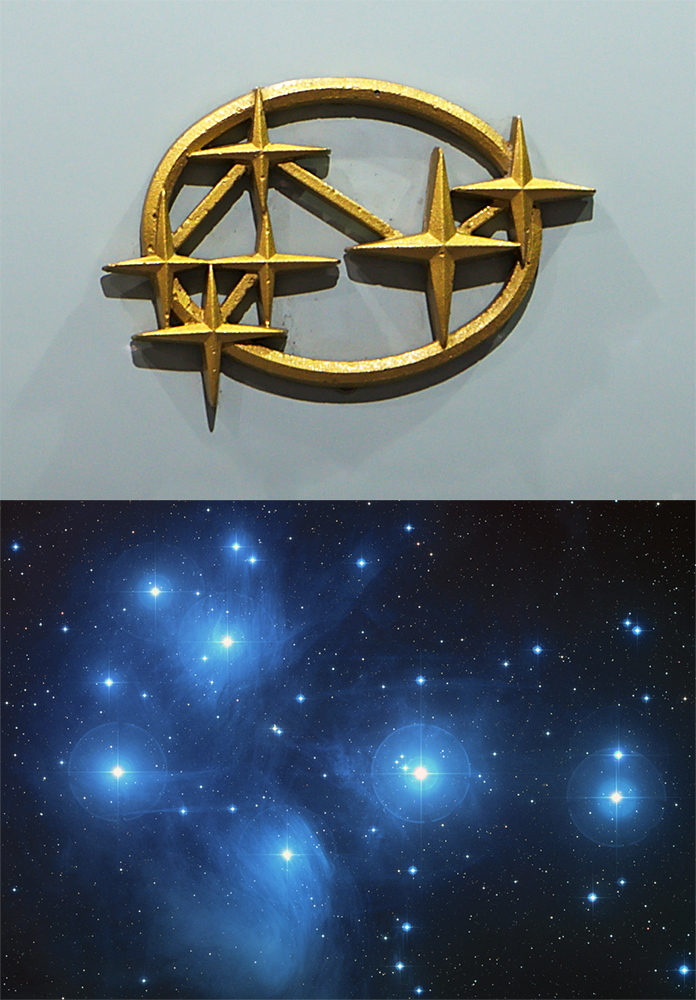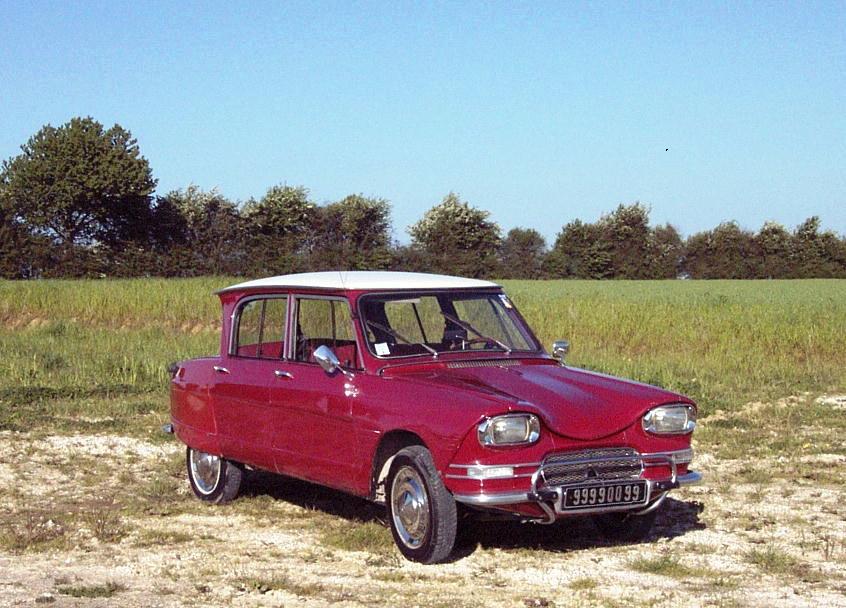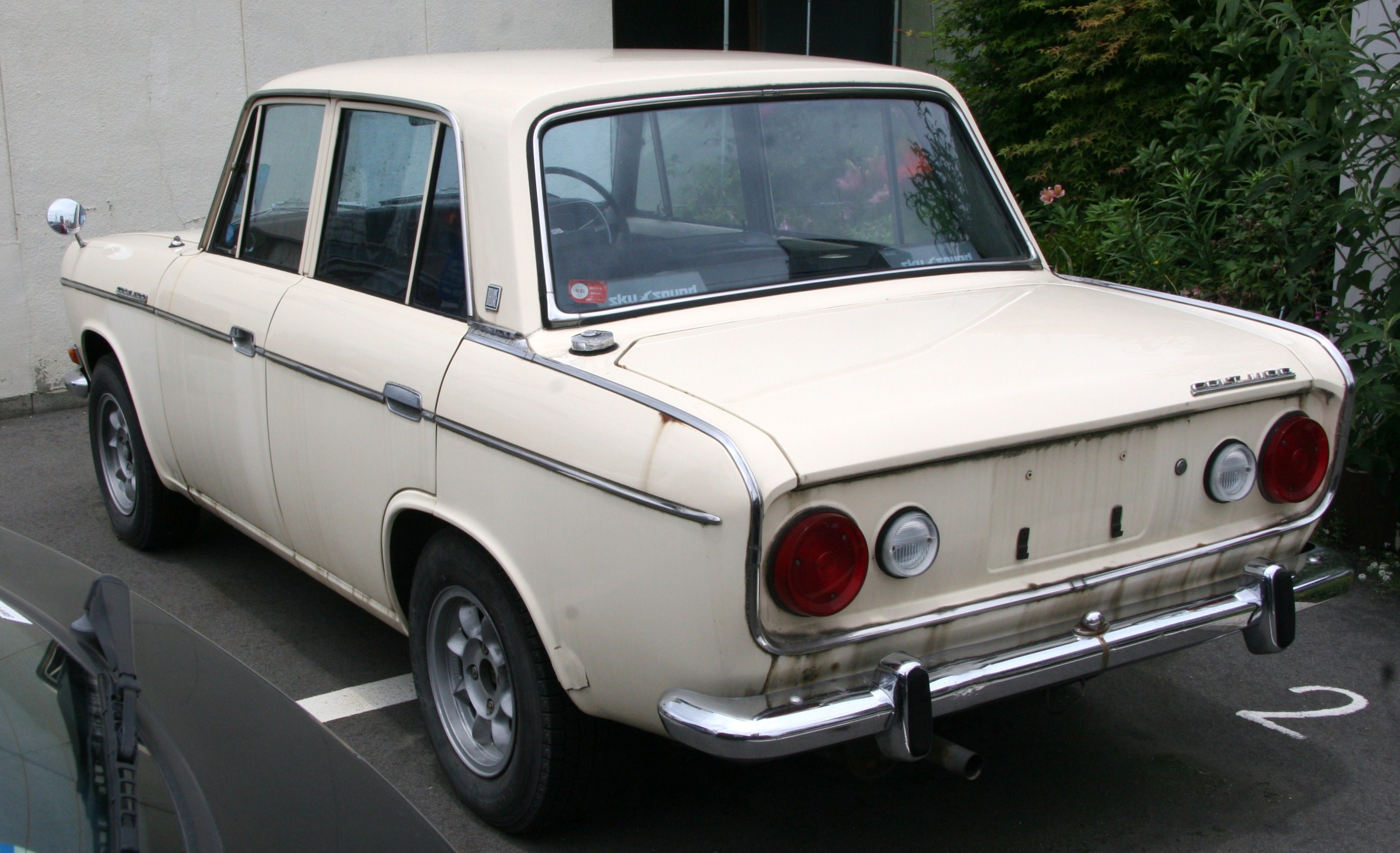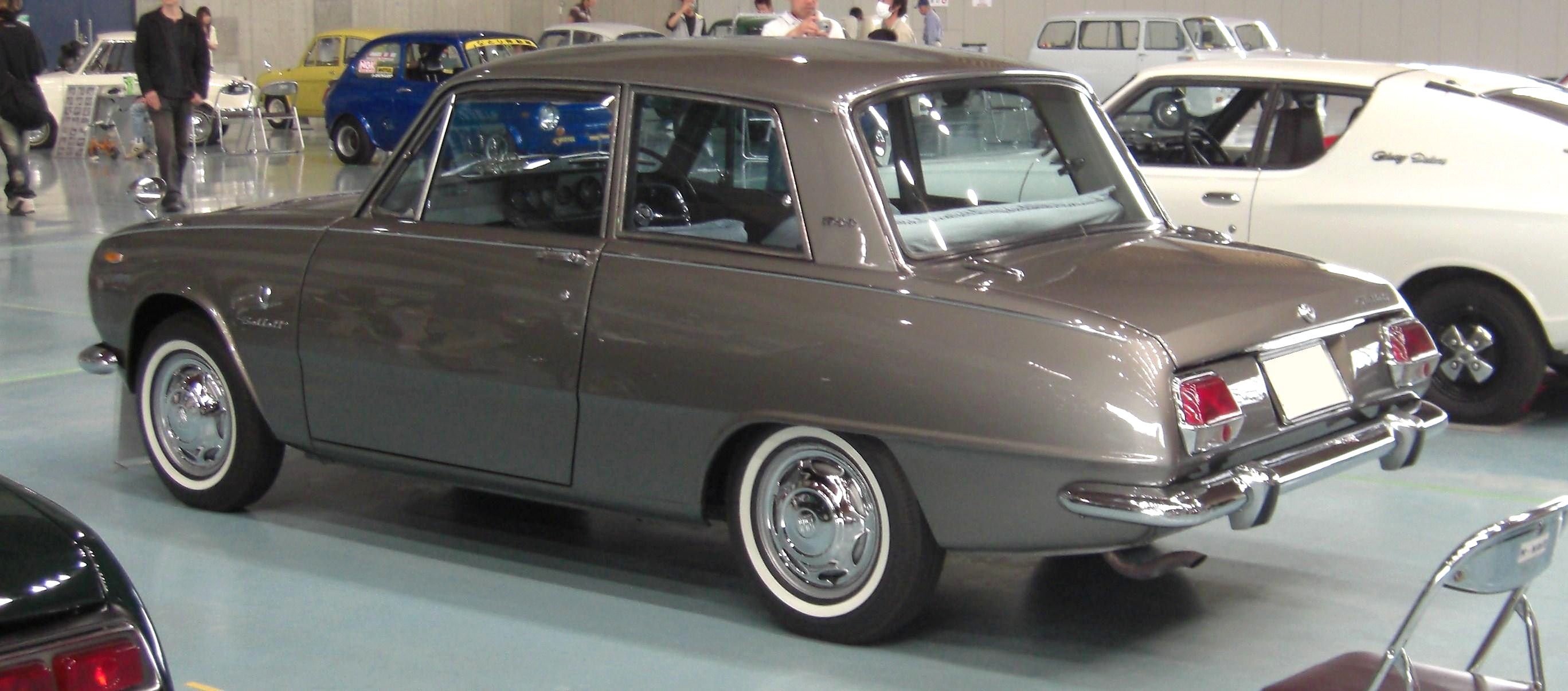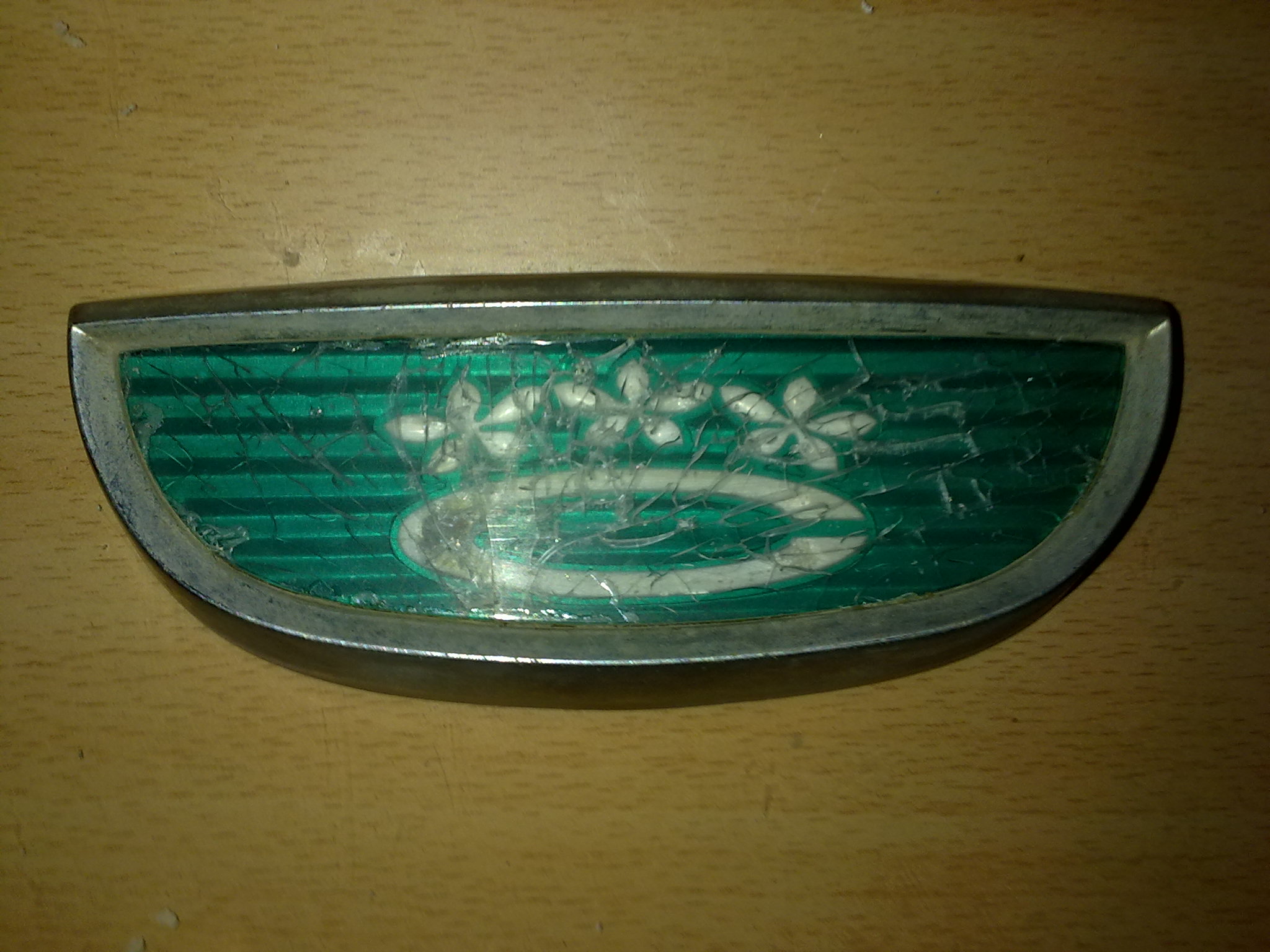|
Subaru 1000
The Subaru 1000 is the first and only front wheel drive Subaru produced by Fuji Heavy Industries that was in the Japanese government "compact car" classification starting in 1966. Previous Subaru models such as the Subaru 360 and the Sambar had been rear-engined, rear wheel drive kei cars. It was the first production Subaru to use a boxer engine, and one of Japan's first front wheel drive cars. History Prototype Subaru A-5 In 1962, Subaru management decided to introduce a successor to the prototype Subaru 1500 with a code name A-5. The engine was technologically advanced for the time; the experimental EA51X was a Otto cycle, overhead camshaft, air-cooled, horizontally opposed four-cylinder engine displacing 980 cc driving the front wheels in a compact car platform. It was to have a double wishbone front suspension. Due to FHI's limited resources, the car was not produced. The Subaru 360 was selling only in Japan at the time but Subaru wanted a car that could comfortably carr ... [...More Info...] [...Related Items...] OR: [Wikipedia] [Google] [Baidu] |
Subaru
( or ; ) is the automobile manufacturing division of Japanese transportation conglomerate Subaru Corporation (formerly known as Fuji Heavy Industries), the twenty-first largest automaker by production worldwide in 2017. Subaru cars are known for their use of a boxer engine layout in most vehicles above 1,500 cc. The Symmetrical All Wheel Drive drive-train layout was introduced in 1972. Both became standard equipment for mid-size and smaller cars in most markets by 1996. The lone exception is the BRZ, introduced in 2012 via a partnership with Toyota, which pairs the boxer engine with rear-wheel-drive. Subaru also offers turbocharged versions of their passenger cars, such as the WRX, Legacy and Outback XT, Ascent, and formerly the Legacy GT and Forester XT. In Western markets, Subaru vehicles have traditionally attracted a small but devoted core of buyers. The company's marketing targets those who desire its signature engine and drive train, all-wheel drive a ... [...More Info...] [...Related Items...] OR: [Wikipedia] [Google] [Baidu] |
Flat-4
A flat-four engine, also known as a horizontally opposed-four engine, is a four-cylinder piston engine with two banks of cylinders lying on opposite sides of a common crankshaft. The most common type of flat-four engine is the boxer-four engine, each pair of opposed pistons moves inwards and outwards at the same time. A boxer-four engine has perfect primary and secondary balance, however, the two cylinder heads means the design is more expensive to produce than an inline-four engine. Boxer-four engines have been used in cars since 1897, especially by Volkswagen and Subaru. They have also occasionally been used in motorcycles and frequently in aircraft. Cessna and Piper use flat four engines from Lycoming and Continental in the most common civil aircraft in the world - the Cessna 172, and Piper Cherokee, while many ultralight and LSA planes use versions of the Rotax 912. Design Most flat-four engines are designed so that each pair of opposing pistons moves inwards and ... [...More Info...] [...Related Items...] OR: [Wikipedia] [Google] [Baidu] |
Citroën Ami
The Citroën Ami is a four-door, front-wheel drive economy (B-segment) family car, manufactured and marketed by Citroën from 1961 to 1978. The Ami was offered in saloon and estate/wagon/break body styles over two generations, the Ami 6 and the Ami 8. The later Ami 8 fastback saloon featured a steeply raked rear window, in contrast to the earlier reverse-raked rear window of the Ami 6 notchback. Over 1,840,396 units were manufactured over the entire production run.John Reynolds. Citroën 2CV. The Ami and Citroën Dyane were replaced by the Citroën Visa and Citroën Axel. Name Ami is the French word for friend. With its 602 cc engine capacity fractionally above the limit for 2 CV designation, the Ami was nicknamed the 3CV, differentiating it from the long established Citroën 2CV. 3CV stands for ''Trois chevaux'', or "three horses" — CV originally being the initials for "chevaux-vapeur" (horsepower – literally 'steam horses'), but used here for " chevaux fisca ... [...More Info...] [...Related Items...] OR: [Wikipedia] [Google] [Baidu] |
Toyota U Engine
The Toyota U engine is a series of flat engines produced by Toyota. The original version of this engine was produced in the 1960s and 1970s in flat-twin configuration. The engine series was extended in 2012 for the engine derived from the Subaru flat-four for the Toyota 86. __TOC__ U The 697 cc U was produced from 1961 through 1966. The power was increased from from engine number U-184170 onwards. It was exclusively installed in the Toyota Publica family of vehicles. 2U The 790 cc 2U was produced from 1965 through 1969, while the similar 2U-B was produced from 1966 through 1976. Output for the 2U-B when fitted to the Publica is at 5,400 rpm. When installed in the Toyota MiniAce (UP100) minitruck and bus series, the engine only produces at 4,600 rpm. This version has an 8.2:1 compression ratio. The 2U-C used in some models of the Publica 20 series produced at 5,000 rpm. It was also installed in the Publica-derived sports car, called the Toyo ... [...More Info...] [...Related Items...] OR: [Wikipedia] [Google] [Baidu] |
Toyota Publica
The is a small car manufactured by the Japanese automaker Toyota from 1961 until 1978. Conceived as a family car to fulfill the requirements of the Japanese Government's "national car concept", it was the smallest Toyota car during that period and was superseded in that role by the Toyota Starlet, which itself started out as a version of the Publica. It was available as a 2-door vehicle only, but in a selection of body styles, ranging from the base sedan (car), sedan through a station wagon, convertible (car), convertible, coupé and even a coupe utility (pickup), which outlived the other models by a decade, and spawned other models, such as the Toyota Sports 800 and the Toyota MiniAce. Development MITI "national car" concept The origins of the Publica can be traced to the "Compact (car)#Japanese market, national car" concept of the powerful Japanese Ministry of International Trade and Industry (MITI), which was announced in 1955. The concept stipulated for a vehicle fulfillin ... [...More Info...] [...Related Items...] OR: [Wikipedia] [Google] [Baidu] |
Drive Shaft
A drive shaft, driveshaft, driving shaft, tailshaft ( Australian English), propeller shaft (prop shaft), or Cardan shaft (after Girolamo Cardano) is a component for transmitting mechanical power and torque and rotation, usually used to connect other components of a drivetrain that cannot be connected directly because of distance or the need to allow for relative movement between them. As torque carriers, drive shafts are subject to torsion and shear stress, equivalent to the difference between the input torque and the load. They must therefore be strong enough to bear the stress, while avoiding too much additional weight as that would in turn increase their inertia. To allow for variations in the alignment and distance between the driving and driven components, drive shafts frequently incorporate one or more universal joints, jaw couplings, or rag joints, and sometimes a splined joint or prismatic joint. History The term ''driveshaft'' first appeared during the mid-1 ... [...More Info...] [...Related Items...] OR: [Wikipedia] [Google] [Baidu] |
Mitsubishi Colt 1000
The Mitsubishi Colt (A20) was one of their first series of passenger cars produced by Shin Mitsubishi Heavy-Industries, Ltd, one of the companies which would become Mitsubishi Motors. Built from 1963 until 1970, they were available in four body styles (2-dr/4-dr sedan, 2-dr van, and 4-dr wagon) and on two different wheelbases, with gradually increasing engine displacements 1000, 1100, 1200, and 1500. After a May 1968 facelift, they were marketed as the "New Colt". Along with the smaller, fastback Colts they formed the mainstay of Mitsubishi's passenger car lineup in the 1960s. With the late 1969 introduction of the new, larger Colt Galant, the outmoded Colt-series soon faded away, eventually replaced by the smaller Mitsubishi Lancer as well. The dimensions were kept small so as to provide Japanese buyers the ability to purchase a car that complied with the Japanese Government compact car dimension regulations and to keep the annual road tax obligation affordable. Colt (series ... [...More Info...] [...Related Items...] OR: [Wikipedia] [Google] [Baidu] |
Isuzu Bellett
The Isuzu Bellett is a subcompact car produced by the Japanese manufacturer Isuzu between 1963 and 1973. Designed by Isuzu, the Bellett replaced the Isuzu Hillman Minx, manufactured by Isuzu under license with the Rootes Group. The car was available as a four-door or two-door sedan, a rare two-door station wagon marketed as a commercial vehicle, called the Bellett Express, and an even rarer one ton commercial variant marketed as the Isuzu Wasp. There was also a four-door sedan with different bodywork and rear suspension, called the Bellett B. Lastly there was a two-door coupé and a fastback version of the same. After General Motors acquired a stake in Isuzu, the Bellett was replaced by GM's "global" T-car, initially called Isuzu Bellett Gemini and later simply Isuzu Gemini, which technically had little to do with its predecessor. A total of 170,737 original Belletts were manufactured. The word Isuzu translated into English means "fifty bells." The nameplate "Bellett" refer ... [...More Info...] [...Related Items...] OR: [Wikipedia] [Google] [Baidu] |
Hino Contessa
The Hino Contessa is an automobile which was produced by Hino Motors from 1961 to 1967. The Contessa was developed largely from the 1947-1961 Renault 4CV powertrain under license to Hino Motors. Offered in both coupe and sedan bodystyles, it replaced the Hino Renault, which was the Renault 4CV manufactured by Hino for Japan. It was adapted into a small pickup truck called the Hino Briska, but used a front engine and rear drive powertrain, while the Contessa used a rear engine and rear drive setup. The PC series coupé was designed by Giovanni Michelotti, while the second generation was longer and wider in both coupé and sedan bodystyles. Unlike many cars found internationally of this time period, using rear drive and rear engined powertrains, the Contessa was water-cooled rather than air-cooled. The name ''contessa'' is Italian for a countess. PC series (1961-1964) 47,299 of the PC-series Contessa were built, between April 1961 and the second quarter of 1964. With an 893&n ... [...More Info...] [...Related Items...] OR: [Wikipedia] [Google] [Baidu] |
Mazda Familia
The , also marketed prominently as the Mazda 323, Mazda Protegé and Mazda Allegro, is a small family car that was manufactured by Mazda between 1963 and 2003. The Familia line was replaced by the Mazda3/Axela for 2004. It was marketed as the ''Familia'' in Japan, which means "family" in Latin. For export, earlier models were sold with nameplates including: "800", "1000", "1200", and "1300". In North America, the 1200 was replaced by the Mazda GLC, with newer models becoming "323" and "Protegé". In Europe, all Familias sold after 1977 were called "323". The Familia was also rebranded as the Ford Laser and Ford Meteor in Asia, Oceania, Southern Africa, some Latin American countries and, from 1991, as the Ford Escort and Mercury Tracer in North America. In addition, the Familia name was used as the Mazda Familia Wagon/Van, a badge-engineered version of the Nissan AD wagon (1994–2017) and Toyota Probox (2018–present). Mazda Familias were manufactured in the Hiroshima Pla ... [...More Info...] [...Related Items...] OR: [Wikipedia] [Google] [Baidu] |
Nissan Sunny
The is an automobile built by the Japanese automaker Nissan from 1966 to 2006. In the early 1980s, the brand changed from Datsun to Nissan in line with other models by the company. Although production of the Sunny in Japan ended in 2006, the name remains in use in China and GCC countries for a rebadged version of the Nissan Almera. In North America, the later models were known as the Nissan Sentra; in Mexico, the Sunny is known as the Nissan Tsuru, which is Japanese for the bird species " crane". The latest versions of the Sunny were larger than the early models, and may be considered compact cars. Earlier versions (through at least the B11 series) were subcompact cars. All Sunnys through the 1982 model year (except as noted below) used Nissan A engine motors. It was designed to compete with the Toyota Corolla. The "Sunny" name has been used on other Nissan models, notably various export versions of the Nissan Pulsar model line. The Sunny has been imported and later manufactur ... [...More Info...] [...Related Items...] OR: [Wikipedia] [Google] [Baidu] |
Toyota Corolla (E10)
The Corolla E10 was the first generation of cars sold by Toyota under the Corolla name. The Corolla was launched in Japan in November 1966 at a Japanese dealership sales channel called ''Toyota Corolla Store''. Eiji Toyoda said it took hard work to create popular demand, and disputed that Toyota rode a wave of private car ownership that was taking off in the mid-1960s. The Corolla's major competitor was the Datsun 1000, released a few months earlier, along with the Subaru 1000 earlier in May. Its companion, the Toyota Sprinter, was sold at a different dealership sales channel called ''Toyota Auto Store''. The Corolla's development was largely influenced by the success and lessons learned from an earlier, smaller vehicle called the Toyota Publica, which used an air-cooled two-cylinder, boxer engine, inspired by the Citroën 2CV. The dealership that was named after the Corolla in Japan was previously known as the ''Toyota Public Store'', to sell the Publica. Design The initia ... [...More Info...] [...Related Items...] OR: [Wikipedia] [Google] [Baidu] |

